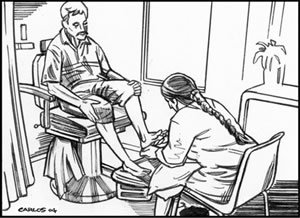Foot and Eye Care
Diabetes and Foot Care
People who have had a foot ulcer need to pay special attention to the care of their feet.
High blood glucose levels over a long period of time can lead to foot problems. Damage includes nerve damage, poor circulation, infection and foot deformities.
Nerve Damage
Nerves in the foot are damaged by high blood glucose levels.
Nerve damage may cause a lack of sensation in the feet. The person may not feel hot water, or realize they have stepped on something sharp.
This lack of feeling in the feet may cause poor balance. Other symptoms might be numbness, burning or tingling in the feet or legs.
Poor Circulation
Blood vessels carry nutrients and oxygen required for healing.
Continued high blood glucose levels cause damage to the blood vessels, making them thick and stiff. This slows down the flow of blood. Good blood flow is required for healthy feet.
Injured feet are slow to heal or don't heal at all. People can feel pain in their calves when walking short distances.
Infection
People with diabetes are less able to fight infections because of their weakened immune system.
Infections can go undetected or can quickly escalate. A symptom of infection would be ulceration of the skin and the tissues of the feet.
Foot Deformities
When a person with diabetes has neuropathy (nerve damage) this leads to foot deformities. Claw toes may also develop.
Lack of feeling may cause imbalance and put stress on other parts of the feet. Corns, calluses, blisters or ulcers can lead to more serious lesions.
Management
Daily management of feet involves:
-
Checking feet every day for signs of redness, corns, calluses, cuts and sores
-
Wearing comfortable well fitting shoes. Shoes with adequate depth and width are recommended
-
Wearing shoes at the beach especially
-
Washing feet and drying them thoroughly, especially between the toes so bacteria and fungi don't grow
-
Wearing bed socks or slippers if feet are cold
-
Checking inside shoes for small stones that can damage the feet
-
Cutting toenails correctly.
How to Avoid Damage to the Feet
The person should:
-
not go barefoot
-
not soak the feet
-
not use heating devices on the feet (e.g. hot water bottles) as the person may not be aware of any burning sensation
-
not wear knee high hosiery or socks with tight tops as these may cause circulation problems.
How to Cut Toenails Correctly
-
do not cut below the shorter edge of the toenails
-
do not cut down the straight side of the toenails.
Visit the Podiatrist If:
-
the toenails are cut incorrectly
-
there are ingrown toenails
-
there is redness and swelling of the foot or ankle
-
there is pain in the legs when the person is at rest or doing exercise
-
there are any open sores
-
there are corns or calluses with discoloration
-
wounds are not healing
-
there is a lack of hair growth on the feet
When to Visit the Podiatrist
A visit to the Podiatrist should occur every 6 months unless otherwise directed by a health professional.
Diabetes and Eye Care
What Can Go Wrong
High blood glucose levels over a long period of time can damage the eyes.
In the beginning this is painless and vision won't be affected, but diabetes can damage the very fine blood vessels in the retina.
This can eventually lead to blindness
Signs To Look For
Blurred vision or flashes of light or pain all mean you should contact the person's doctor straight away.
Blurred Vision
Blurred vision can be due to clouding of the lens, which may lead to cataract formation.
It may also be due to increased pressure in the eye, which may lead to glaucoma.
It can also be caused because of diabetic retinopathy where the small blood vessels have become fragile and leaky.
Management
Eyes need to be checked weekly for blurriness.
This can be done by asking the person about their vision or observing how they walk.
If vision problems are beginning, they may bump into things when walking, or they may trip.
Whilst eating they may miss their food when trying to put it on a fork or into their mouth.
When to Visit the Eye Specialist
Visit the eye specialist every 12 months unless directed otherwise.
During this visit an ophthalmoscope will be used to look through the pupil of the eye to check the retina.
This is where damage can occur in eyes due to long-term high blood glucose levels.
When the doctor examines the eyes he/she will put some drops into the eyes (the drops may sting).
These make the pupils larger by relaxing the tiny muscles around them so that the retina can be checked. For a few hours after the drops are put in the person's vision will be blurred, particularly in bright lights.
Wearing sunglasses outside may help. Support will be required.

